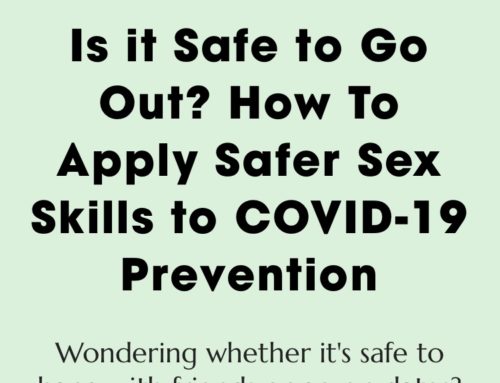
On Teen Vogue: Queer Sex 101
by: Yana Tallon-Hicks
How to Have Sex if You're Queer: What to Know About Protection, Consent, and What Queer Sex Means
Rarely does traditional sex education tackle pleasure for pleasure’s sake, how to have sex for non-reproductive purposes, or the wide spectrums of sexualities, bodies, and genders that exist. Instead it tends to cover penis-in-vagina penetration only, pregnancy risks, and STI/STD transmission, leaning heavily on scare tactics that may not even work.
Traditional sex ed is failing us all, but when it comes to standardized sex education in the U.S., the LGBTQ community is especially left outof the conversation. A GLSEN National School Climate Survey found that fewer than 5% of LGBTQ students had health classes that included positive representations of LGBTQ-related topics. Among self-identified “millennials” surveyed in 2015, only 12% said their sex education classes covered same-sex relationships at all.
The good, and even possibly great news is that not being boxed in by the narrow definitions of sex provided to us via traditional sex ed means that we are free (and perhaps even empowered!) to build our own sex lives that work uniquely for us, our partners, and our relationships. But we still need some info in order to do so.
Let’s talk about what classic sex education might’ve missed about how to have sex if you’re queer, from what sex between queer people means to how to keep it safe and consensual between the rainbow sheets.
What Queer Sex Means and How to Have it
Redefine and self-define sex. Sexual desire exists on a spectrum just like gender, sexuality, and other fluid and fluctuating parts of our identities. From Ace to Gray-Ace to Allosexual and everywhere in between and beyond, check in with yourself and your partners about how they experience sexual desire (if at all).
Similarly, “having sex” can mean a million different things to a million different people from making out, to certain kinds of penetration, orgasmic experiences, etc. You get to decide “what counts as sex” to you which is especially true when it comes to sexual debuts — a necessary and inclusive term for self-determined first times that looks beyond the traditional, heterosexist version of “losing your virginity.”
Honoring the identities and bodies of ourselves and our partners with respect, kindness, compassion, and tenderness is crucial and can feel even more precious and rewarding when you’re queer. Truly pleasurable sex — regardless of your identity — starts with a sense of safety, clear communication, confident boundaries, active listening skills, and self-awareness.

Check in with yourself first. Active consent starts with knowing yourself and what your boundaries are. Though an important piece of practicing consent is asking your partner for permission and for their preferences, it can be easy to forget to ask yourself similar questions. What do you want out of a sexual experience? Where are you confident you don’t want to venture now, yet, or maybe ever? What are you super excited to explore?
This check-in can help you determine what you want from sex and what queer sex means to you. This is when you can think about experimenting with sex toys, whether you’re interested in penetration, and what kind of touch feels good to you.
Sometimes we don’t even know where to start if we’re not sure about what our options even are. Scarleteen.com or Girl Sex 101 (much more gender-spectrum-inclusive than the title suggests) are both great resources that can get some of your questions answered. You can also find more information here.
Name your own bits. Body parts, especially private body parts, can be complicated territory for LGBTQ folks, and understandably so. One of the main goals of sex for many of us is to feel good in our bodies. The first step to this can be feeling good about the terms we use for our body parts. Try on one or a few that might work for you, communicate them to your partners (especially new ones), and ask them how they like their bodies to be talked about or touched.
Gender roles are bendable roles. You don’t have to adopt traditional gender roles in sex unless you want to. Media mediums from PG-13 sex scenes to X-rated porn can create clear splits between what’s considered being “sexually masculine” (being the do-er, taking control, knowing the ropes) and being “sexually feminine” (being the receiver, being passive or reactive, being led rather than initiating the sexual interaction).
Just because you identify with being masculine, feminine, or somewhere in between doesn’t mean you need to act a certain way or do anything in particular in your sex life. You can be a Ferociously Fierce Femme, a Passive Prince of Pillows, a Non-Binary Take-Charge Babe, or any version of your sexual self that follows what feels good, affirming, and right to you and your partners.
Talk about sex outside of a sexual context. Talking about sex with your potential or current partners before the clothes come off can be a great way to keep clear-headed communication and consent thriving. Sexual interactions are vulnerable, exciting, and can get your body and brain functioning in all new ways. So, sometimes it can be easier to talk about your feelings about sex, your enthusiastic Yes-es, your definite No’s, and your curious Maybes over coffee or text first, in addition to in-the-moment communication about consent.
Make an aftercare plan. We know that consent, permission, and pre-sex talks are all important parts of a healthy sex life, but we can forget to think about what happens after we have sex (besides water, a pee break, and snacks, of course). This is aftercare — or, how we like to be interacted with after sex has ended.
Aftercare preferences can include what we want to do immediately after sex (cuddle? watch Netflix? have some alone time?) and can also include what happens in the upcoming days or weeks (check-ins over text? gossip parameters? is there anyone you and your partner definitely do or don’t want to dish to?).
No matter your aftercare preferences, a post-sex check-in conversation about how things went, what you’d love an encore of, and what you might want to avoid next time (if you’d like there to be a next time) is always a good idea.
.jpg)
Molly Cranna
Always keep it consensual. Consent starts with asking permission before any sexual touch or interaction begins, continues with checking in about how things are going, and ends with talking with each other about how the sexual interaction went overall so that feedback can be exchanged and any mistakes can be repaired.
True, enthusiastic consent thrives in a space where each person feels free, clear-headed, and safe to speak up about what their No’s, Yes-es, and Maybes are.
Safer Sex for Queer Sex
Hormones matter. Even though testosterone hormones can decrease your risk of unwanted pregnancy, folks on T can still become pregnant, so make sure to use condoms if sperm is likely to be in the mix. Estrogen hormones can slow sperm production, but if your body is still producing sperm, an egg-creating partner could still get pregnant, so put your favorite birth control method to work…continue reading on teenvogue.com!


